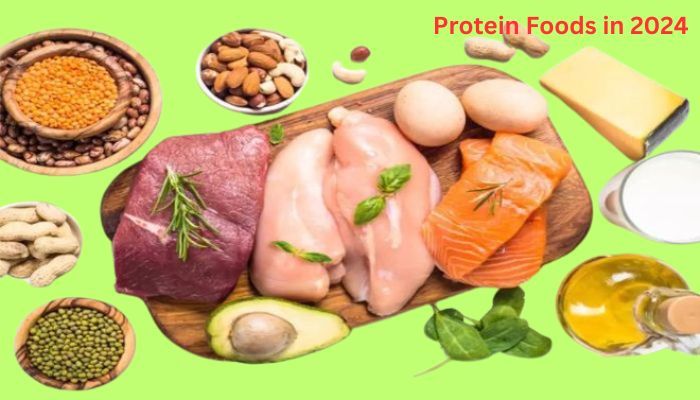Plant-Based Protein Foods
Plant-based protein foods are becoming increasingly popular, especially among vegetarians and vegans. While most plant proteins are incomplete, meaning they lack one or more essential amino acids, combining different plant-based protein foods can provide all the necessary nutrients. Here are some top plant-based protein sources:
- Legumes: Beans, lentils, chickpeas, and peas are rich in protein and fibre, making them excellent protein foods for vegetarians.
- Nuts and Seeds: Almonds, walnuts, chia seeds, and flaxseeds are good sources of protein and healthy fats. They can be easily added to various dishes to boost protein content.
- Soy Products: Tofu, tempeh, and edamame are high-protein foods derived from soybeans. They are versatile and can be used in a variety of recipes.
- Grains: Quinoa, amaranth, and farro are ancient grains that provide a decent amount of protein along with other essential nutrients like fibre and iron.
- Vegetables: Some vegetables, such as broccoli, spinach, and Brussels sprouts, contain significant amounts of protein. While they may not be as protein-dense as other sources, they contribute to overall protein intake.
In 2024, the food industry continues to innovate, introducing new protein foods that cater to diverse dietary needs and preferences. Here are some emerging protein foods:
- Insect Protein: Edible insects, such as crickets and mealworms, are gaining popularity as sustainable and nutrient-dense protein foods.
- Algae Protein: Algae, including spirulina and chlorella, are rich in protein and other nutrients, making them an excellent supplement for protein foods.
- Lab-Grown Meat: Also known as cultured or cell-based meat, this innovative approach produces meat by cultivating animal cells, offering a sustainable alternative to traditional meat.
- Protein Powders: Plant-based protein powders, such as pea protein and rice protein, are widely used in smoothies and baking to increase protein intake.
Chapter 3: Protein Foods and Dietary Requirements
Daily Protein Requirements
The recommended daily intake of protein varies based on age, sex, and activity level. The general guideline is to consume 0.8 grams of protein per kilogram of body weight. However, individuals with higher activity levels or specific health goals may require more protein foods.
Protein Foods for Different Life Stages
- Children and Adolescents: Growing children and teenagers need ample protein foods to support their rapid growth and development.
- Adults: Adults should focus on maintaining muscle mass and overall health by consuming a balanced amount of protein foods.
- Older Adults: As we age, muscle mass naturally declines, making protein foods crucial for preserving muscle and preventing sarcopenia.
- Pregnant and Breastfeeding Women: Increased protein intake is essential for the growth and development of the baby and maintaining the mother’s health.
Protein Foods for Athletes
Athletes and individuals with high physical activity levels have increased protein needs to support muscle repair and growth. Consuming protein foods post-exercise can enhance recovery and improve performance.
Protein Foods for Vegetarians and Vegans
Vegetarians and vegans can meet their protein needs by combining different plant-based protein foods to ensure they get all essential amino acids. For example, pairing legumes with grains can provide a complete protein profile.
Chapter 4: Incorporating Protein Foods into Your Diet
Breakfast
Starting your day with protein foods can keep you full and energised. Here are some protein-rich breakfast ideas:
- Greek Yoghurt with Nuts and Berries: Greek yoghurt is a high-protein food that pairs well with nuts and berries for added nutrients.
- Egg Omelette with Vegetables: An omelette made with eggs and a variety of vegetables is a great way to boost your protein intake.
- Smoothies with Protein Powder: Blend your favourite fruits with a scoop of protein powder and a base of milk or plant-based milk for a nutritious start to the day.
Lunch
Incorporate protein foods into your lunch to sustain energy levels throughout the day. Here are some lunch ideas:
- Chicken Salad: A salad topped with grilled chicken breast, mixed greens, and a variety of vegetables is both nutritious and satisfying.
- Lentil Soup: Lentil soup is a hearty and protein-packed option, perfect for a warm, comforting meal.
- Quinoa and Black Bean Bowl: Combine quinoa, black beans, corn, and avocado for a delicious and protein-rich bowl.
Dinner
End your day with a balanced meal that includes protein foods. Here are some dinner ideas:
- Grilled Salmon with Vegetables: Salmon is a rich source of protein and omega-3 fatty acids, making it an excellent choice for dinner.
- Tofu Stir-Fry: Tofu stir-fried with colourful vegetables and served over brown rice provides a complete meal with plenty of protein.
- Beef and Broccoli: A classic dish that combines beef and broccoli, served with a side of rice or noodles, is both tasty and protein-packed.
Snacks
Incorporating protein foods into your snacks can help curb hunger and provide sustained energy. Here are some snack ideas:
- Hard-Boiled Eggs: Hard-boiled eggs are a convenient and portable protein snack.
- Hummus with Veggies: Hummus made from chickpeas pairs well with raw vegetables for a protein-rich snack.
- Protein Bars: Choose protein bars with natural ingredients for a quick and easy protein boost.
Chapter 5: Special Considerations for Protein Foods
Allergies and Intolerances
Some individuals may have allergies or intolerances to certain protein foods, such as dairy or soy. It’s important to identify and avoid these allergens and find alternative protein sources.
Sustainable Protein Foods
With growing environmental concerns, sustainable protein foods are gaining attention. Opting for plant-based proteins, insect protein, and lab-grown meat can reduce the ecological footprint associated with traditional animal farming.
Protein Foods and Chronic Diseases
Protein foods play a role in managing and preventing chronic diseases. For example, high-protein diets can help regulate blood sugar levels in individuals



2 Replies to “Protein Foods in 2024”